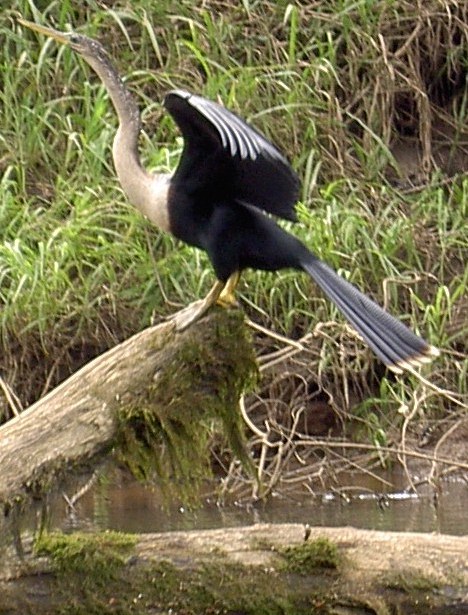- Anhinga
Taxobox
name = Anhinga
status = LC
status_ref = citation|author=BirdLife International|year=2008|id=49544|title=Anhinga - BirdLife Species Factsheet|url=http://www.birdlife.org/datazone/species/index.html?action=SpcHTMDetails.asp&sid=3660&m=0|accessdate=15-Sep-2008 ]
status_system = iucn3.1

image_caption = Female Anhinga drying its feathers, Costa Rica
regnum =Animal ia
phylum = Chordata
classis =Aves
ordo =Pelecaniformes
familia = Anhingidae
genus = "Anhinga"
species = "A. anhinga"
binomial = "Anhinga anhinga"
binomial_authority = (Linnaeus,1766 ):"For the bird genus Anhinga, see
Darter "The Anhinga ("Anhinga anhinga"), sometimes called Snakebird, Darter, American Darter, or Water Turkey, is a water bird of the warmer parts of
North America andSouth America . The word "anhinga" comes from the BrazilianTupi language and meansdevil bird orsnake bird .It is a
cormorant -likebird with an average body length of 85 cm (35 in), a wingspan of 117 cm (45 in), and a weight of 1,350 g. It is a dark-plumaged fish-eater with a very long neck, and often swims with only the neck above water. When swimming in this style the name Snakebird is apparent, since only the colored neck appears above water the bird looks like a snake ready to strike.The Anhinga is a member of the darter family,
Anhingidae , and is closely related to Indian ("Anhinga melanogaster"), African ("Anhinga rufa"), and Australian ("Anhinga novaehollandiae") Darters.The Anhinga's feathers are not waterproofed by oils like those of
duck s, and can get waterlogged, causing the bird to become barely buoyant. However, this allows it to dive easily and search for fish under the water. It can stay down for significant periods.When necessary, the Anhinga will dry out its wings and feathers. It will perch for long periods with its wings spread to allow the drying process, as do cormorants. If it attempts to fly while its wings are wet, it has great difficulty getting off the water and takes off by flapping vigorously while 'running' on the water. Anhinga will often search for food in small groups.
Distribution and migration
The anhinga genus is found all over the world in warm shallow waters.cite book|title=Common Coastal Birds of Florida and the Caribbean|author=Nellis, David W.|publisher=Pineapple Press, Inc.|year=2001|pages=110|id=ISBN 978-1-5616-4191-8] The American Anhinga has been subdivided into two subspecies - "A. a. anhinga" and "A. a. leucogaster" - based on their location. "A. a. anhinga" can be found mainly east of the
Andes inSouth America and also the islands ofTrinidad and Tobago . "A. a. leucogaster" can be found in the southernUnited States ,Mexico ,Cuba , andGrenada .cite book|title=Birds of Mexico: a guide for field identification|author=Blake, Emmet Reid|publisher=University of Chicago Press|year=1953|pages=151-152|id=ISBN 0-2260-5641-4]Only birds that live in the extreme north and south of their range migrate and do so based on
temperature and availablesunlight . Anhingas will migrate towards theequator during winter but this range is "determined by the amount of sunshine to warm the chilled birds". Although not in their usual range, anhingas have been found as far north as the states ofPennsylvania cite book|title=Birds of Pennsylvania|author=Gerald M. McWilliams, Daniel W. Brauning|publisher=Cornell University Press|year=1999|pages=43|id=ISBN 978-0-8014-3643-7] andWisconsin cite book|title=Wisconsin Birdlife: Population and Distribution Past and Present|author=Robbins,Samuel D.|publisher=University of Wisconsin Press|year=1991|pages=127-128|id=ISBN 978-0-2991-0260-9] in theUnited States .Kettles of anhingas often migrate with other birds and have been described as resembling black paper gliders.cite book|title=Birdlife of Houston, Galveston, and the Upper Texas Coast|author=Ted L. Eubanks, Robert A. Behrstock, Ron J. Weeks|publisher=Texas A&M University Press|year=2006|pages=70|id=ISBN 978-1-5854-4510-3]
Physical description and taxonomy
The "A. anhinga" species is a large bird and measures approximately 35 in (88.9 cm) in length with a 45 in (1.14 m) wingspan.cite book|title=The Sibley Field Guide to Birds of Eastern North America|author=Sibley, David Allen|publisher=Alfred A. Knopf, New York|year=2003|pages=45|id=ISBN 0-679-45120-X] The "A. a. anhinga" is larger than "A. a. leucogaster" and has "broader buffy tail lips". The weight is 2.7 lb (1.22 kg).cite book|title=Florida's Birds: A Field Guide and Reference|author=David S. Maehr, H. W. Kale, Herbert W. Kale, II|publisher=Pineapple Press Inc|year=2005|pages=33,38|id=ISBN 1-5616-4335-1] The bill is longcite book|title=Birds of North America, Revised and Updated: A Guide to Field Identification|author=Chandler S. Robbins, Bertel Bruun, Herbert S. Zim|publisher=Macmillan|year=2001|pages=36|id=ISBN 1-5823-8090-2] (about twice the length of the headcite book|title=The Birds of America|author=Audubon, John James|publisher=J.B. Chevalier|year=1843|pages=443-457] ), sharply pointed and yellow as are the webbed feet.
Most of the male Anhinga's body is a glossy black green with the wings, base of wings, and tail being a glossy black blue. The tip of the tail has white feathers.cite book|title=Birds of North America|author=Tom Wood, Sheri L. Williamson, Jeffrey Glassberg|publisher=Sterling Publishing Company, Inc.|pages=50|id=ISBN 1-4027-2821-2] The back of the head and the neck have elongated feathers that have been described as graycite book|title=Handbook of Birds of Eastern North America|author=Chapman, Frank M.|publisher=Harvard University|page=93] or light purple white. The upper back of the body and wings is spotted or streaked with white.
The female Anhinga is similar to the male Anhinga except that it has a pale gray-buffcite book|title=International Wildlife Encyclopedia|author=Burton, Maurice; Burton Robert|publisher=Marshall Cavendish|year=2002|pages=646|id=ISBN 0761472711] or light browncite book|title=Guide to the Lake Okeechobee Area|author=Gregware, Bill; Gregware, Carol|publisher=Pineapple Press Inc|year=1997|pages=54|id=ISBN 1561641294] head, neck, and upper chest. The lower chest or breast is a chestnut color and as compared to the male, the female has a more brown backcite book|title=Birds of the High Andes|author=Jon Fjeldså, NielsKrabbe, Povl Jørgensen, Jens Ole Byskov|publisher=Apollo Books|year=1990|pages=74|id=ISBN 8788757161] .
The hatchling starts out bald but gains tan down within a few days of hatching. Within two weeks the tan down has been replaced by white down. Three weeks after hatching, the first juvenile feathers appear. Juveniles are mostly brown until first breeding after the second or third winter.
Conservation status
The Anhinga is protected in the US under the
Migratory Bird Treaty Act of 1918 . [citation|author=U.S. Fish and Wildlife Service|year=1995|title=BIRDS PROTECTED BY THE MIGRATORY BIRD TREATY ACT|url=http://www.fws.gov/migratorybirds/intrnltr/mbta/mbtandx.html|accessdate=2008-09-15 ] The number of individual anhingas have not been estimated but they are considered to be ofleast concern because of the frequency of their occurrence in their 15,000,000 km² global range.References
External links
* [http://ibc.hbw.com/ibc/phtml/especie.phtml?idEspecie=271 Anhinga videos] on the Internet Bird Collection
Wikimedia Foundation. 2010.
